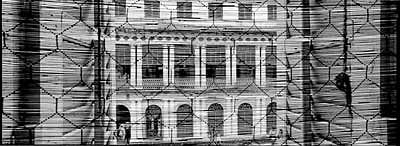
‘Kolkata is like a huge labyrinthine courtyard where an ongoing theatre performance unfolds,” says ace photographer Saibal Das. This internationally acclaimed visual chronicler has won, among other awards in his field, the UNESCO award and the National Media Fellowship from National Foundation for India (NFI). Photos from his current Chitpore series have been published in GEO magazine and elsewhere.
Saibal sees the drama of life manifesting every day and every hour in the streets of his native city. He observes with empathy and joy the urban landscape of contrasts, the amusing and preposterous, the intense and the moderate, all co-existing in the struggle for survival.
In Kolkata, relics of past grandeur overlap with the present decay and the promise of a better tomorrow. In a wall of a grand old mansion, popularly called ‘Putul Bari’ or the house of dolls because of many beautiful statues adorning its imposing façade, Saibal brings to our notice with quiet humour the presence of a solitary urinal. It is a practical necessity, but looks absurd when juxtaposed against the vestiges of bygone glory.
Saibal’s camera captures images of tradition jostling with modernity. In a narrow lane, a young woman dressed in a smart pantsuit rushes off to work past a century old home, with an antique statue peering out enigmatically from its walls. Here migrant workers in the bastis and prostitutes rub shoulders with the decaying aristocracy and rich Marwari traders. Kolkata’s teeming millions are a harmonious mix of natives and people from all corners of the country and the world. Each community observes its age old traditions and these multiple heritages are respected by fellow citizens. Handling the camera ever since childhood, Saibal captures this unique milieu in striking visual images.
His project of capturing the undying spirit of Kolkata began one rainy morning during his journalistic assignments. “I came upon a baby struggling to wriggle out of a shack but tumbling over and over again. His futile struggle and the glint in the eye trying to see the rain washed world outside entranced me, and I thought of capturing the pulse of a place that nestles so much diversity under its sky.” He once did a photo feature for India Today on Chitpore. But as he matured as an artist and a human being, he felt there was much more to see, say, and capture in visual images. A lifelong native of Kolkata, work took him to live for over a decade in other cities. Upon returning home, he saw his city with a fresh perspective.
Chitpore in old North Kolkata is renamed as Rabindra Sarani. Spanning the areas from Bagbazar to MG Road, Chitpore’s denizens are a happy mix of Bengalis, Muslims and Rajasthanis. Chitpore within Kolkata is a more than a mere urban space. It is a microcosm of a world of diversities.
Amid the hubbub of a modern Indian city, the ancestral mansion of the Tagore family in Jorasanko stands testimony to a lost world while the lurid posters of a shrinking jatrapara show a different underbelly.
Constructed in the 18th century by Dwarakanath Tagore, the grandfather of Rabindranath Tagore, the Thakurbari at Jorasanko was once a focal point of the Bengal Renaissance. New art, literature and social reform movements took roots here. Today, the mansion houses a museum and the Rabindra Bharati University.
Saibal’s photographs capture the decay of old glory. In a quiet corner of the university’s sculpture department, a crumbling statue stands abandoned in a tragi-comic pose beside a dilapidated staircase leading to some mysterious destination. Poila Baisakh, the birth anniversary of Rabindranath Tagore, is celebrated with festive zest by every true-blue Bengali. Roadside vendors take the occasion to peddle kitschy portraits of Bengal’s cultural icon. “It is as though Tagore has now become another marketable commodity,” Saibal observes.
Chitpore during its heyday was home to many literary and cultural greats. Today, the house of famed playwright Girish Ghosh stands frozen in time right in the middle of a busy road. The famed Minerva Theatre once saw great Bengali tragedies and comedies played out and appreciated by the city’s cultural elite. In time, the place degenerated into a pickup joint. The government took up the cause of restoring the Minerva, and plays are being staged here again.
Chitpore also houses the artists of Kumartuli, who create beautiful images of the Mother Goddess for Durga Puja. Here Chinese New Year is celebrated with equal enthusiasm along with Idd.
Some festivals such as the Annakut festival and Gopal Puja are celebrated only in this area of Kolkata. One shot captures a Bihari migrant family celebrating their traditional Chhaat Puja. So many processions take place here, Saibal notes. On April 30, the sex workers of Sonargachi in the Chitpore area take out a midnight torchlight procession to celebrate May Day.
“Today, digital photography is simple, cheaper, and accessible to everyone,” Saibal observes. “People are clicking pictures fast and furiously on mobile phones and freely posting them on the Internet. But creating enduring images isn’t like fast food,” he says. “A professional photographer needs to take his art seriously, and not as light fun.”
Armed with his camera, he embarks on solitary walks through his city’s streets, savouring each scene and moment slowly with the eyes of a connoisseur. Finding fresh meanings and nuances in the world around him, he freezes them for viewers to enjoy and make their own interpretations and conclusions.
“This series is a work in progress,” he says, “like the city itself. Each day reveals new facets and insights on life, its sheer unpredictability. Each shot frames a drama, having its own story to tell, which promises never to end. Chitpore is now part of my evolution as a photographer and a human being.”
